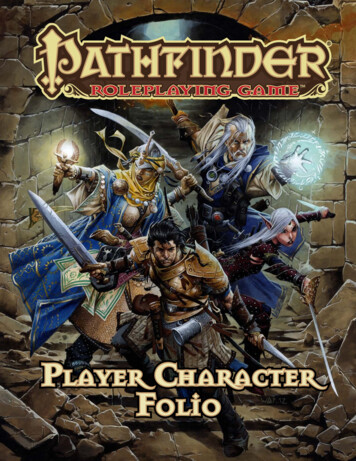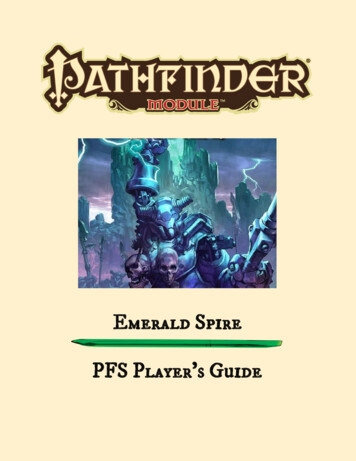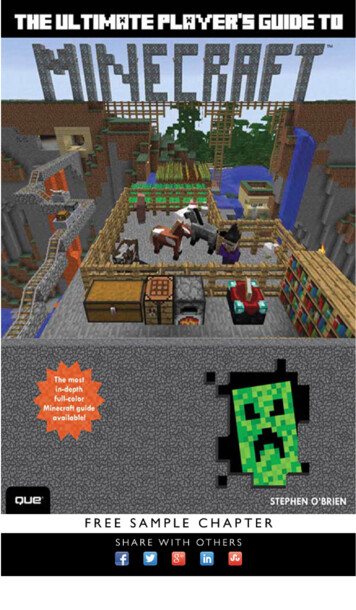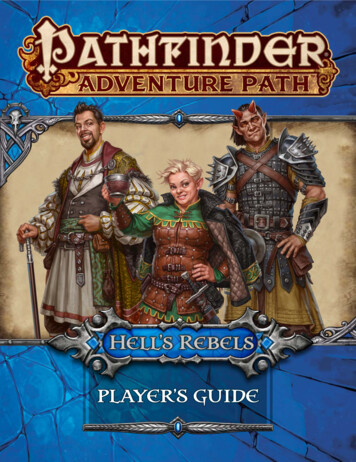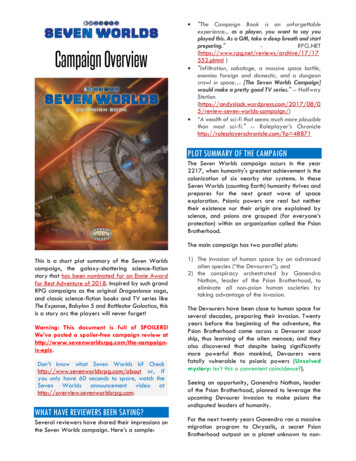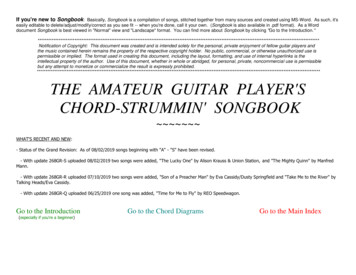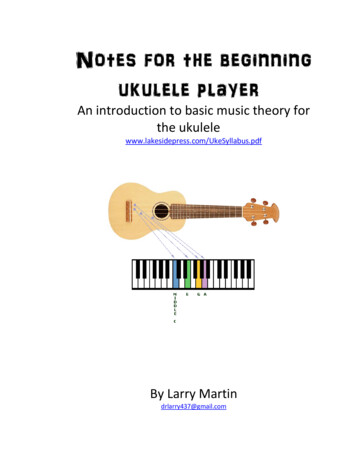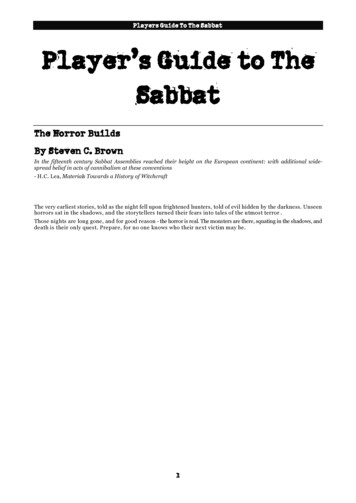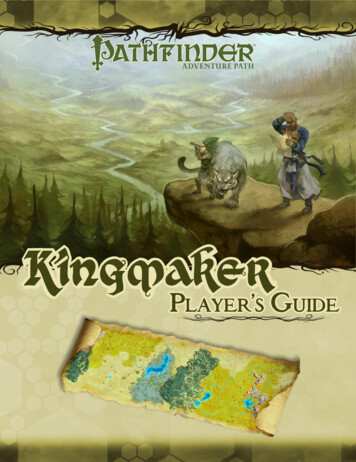
Transcription
UNCORRECTED PROOF. NOT FOR RESALEReadyPlayerOne
UNCORRECTED PROOF. NOT FOR RESALE
UNCORRECTED PROOF. NOT FOR RESALEReadyPlayerOneErnest ClineCrown PublishersNew York
UNCORRECTED PROOF. NOT FOR RESALEThis is a work of fiction. Names, characters, places, and incidents either are the productof the author’s imagination or are used fictitiously. Any resemblance to actual persons,living or dead, events, or locales is entirely coincidental.Copyright 2011 by Dark All Day, Inc.All rights reserved.Published in the United States by Crown Publishers, an imprint of the CrownPublishing Group, a division of Random House, Inc., New York.www.crownpublishing.comcr own and the Crown colophon are registered trademarks of Random House, Inc.Library of Congress Cataloging-in-Publication DataCline, Ernest.Ready player one : a novel / Ernest Cline.—1st ed.p. cm.1. Regression (Civilization) —Fiction. 2. Virtual reality—Fiction. 3. Utopias—Fiction. 4. Puzzles—Fiction. I. Title.PS3603.L548R43 2011813'.6—dc222011015247ISBN 978-0-307-88743-6eISBN 978-0-307-88745-0Printed in the United States of AmericaBook design by Ralph Fowler/rlfdesignJacket design by Christopher Brand10 9 8 7 6 5 4 3 2 1First Edition
UNCORRECTED PROOF. NOT FOR RESALEFor Susan and LibbyBecause there is no map for where we are going
UNCORRECTED PROOF. NOT FOR RESALE
UNCORRECTED PROOF. NOT FOR RESALE0000Everyone my age remembers where they were and what theywere doing when they first heard about the contest. I was sitting in myhideout watching cartoons when the news bulletin broke in on my videofeed, announcing that James Halliday had died during the night.I’d heard of Halliday, of course. Everyone had. He was the videogamedesigner responsible for creating the OASIS, a massively multiplayer online game that had gradually evolved into the globally networked virtualreality most of humanity now used on a daily basis. The unprecedentedsuccess of the OASIS had made Halliday one of the wealthiest people inthe world.At first, I couldn’t understand why the media was making such a bigdeal of the billionaire’s death. After all, the people of Planet Earth hadother concerns. The ongoing energy crisis. Catastrophic climate change.Widespread famine, poverty, and disease. Half a dozen wars. You know:“dogs and cats living together . . . mass hysteria!” Normally, the newsfeeds didn’t interrupt everyone’s interactive sitcoms and soap operas unless something really major had happened. Like the outbreak of somenew killer virus, or another major city vanishing in a mushroom cloud.Big stuff like that. As famous as he was, Halliday’s death should have warranted only a brief segment on the evening news, so the unwashed massescould shake their heads in envy when the newscasters announced the obscenely large amount of money that would be doled out to the rich man’sheirs.
UNCORRECTED PROOF. NOT FOR RESALE2 : Ernest ClineBut that was the rub. James Halliday had no heirs.He had died a sixty-seven-year-old bachelor, with no living relativesand, by most accounts, without a single friend. He’d spent the last fifteenyears of his life in self-imposed isolation, during which time—if the rumors were to be believed—he’d gone completely insane.So the real jaw-dropping news that January morning, the news thathad everyone from Toronto to Tokyo crapping in their cornflakes, concerned the contents of Halliday’s last will and testament, and the fate ofhis vast fortune.Halliday had prepared a short video message, along with instructionsthat it be released to the world media at the time of his death. He’d also arranged to have a copy of the video e-mailed to every single OASIS user thatsame morning. I still remember hearing the familiar electronic chime whenit arrived in my inbox, just a few seconds after I saw that fi rst news bulletin.His video message was actually a meticulously constructed short filmtitled Anorak’s Invitation. A famous eccentric, Halliday had harbored alifelong obsession with the 1980s, the decade during which he’d been ateenager, and Anorak’s Invitation was crammed with obscure ’80s popculture references, nearly all of which were lost on me the first time Iviewed it.The entire video was just over five minutes in length, and in the daysand weeks that followed, it would become the most scrutinized piece offilm in history, surpassing even the Zapruder film in the amount of painstaking frame-by-frame analysis devoted to it. My entire generation wouldcome to know every second of Halliday’s message by heart.Anorak’s Invitation begins with the sound of trumpets, the opening of anold song called “Dead Man’s Party.”The song plays over a dark screen for the first few seconds, until thetrumpets are joined by a guitar, and that’s when Halliday appears. Buthe’s not a sixty-seven-year-old man, ravaged by time and illness. He looksjust as he did on the cover of Time magazine back in 2014, a tall, thin,healthy man in his early forties, with unkempt hair and his trademarkhorn-rimmed eyeglasses. He’s also wearing the same clothing he wore inthe Time cover photo: faded jeans and a vintage Space Invaders T-shirt.Halliday is at a high-school dance being held in a large gymnasium. He’s
UNCORRECTED PROOF. NOT FOR RESALEReady Player One : 3surrounded by teenagers whose clothing, hairstyles, and dance moves allindicate that the time period is the late 1980s.* Halliday is dancing, too—something no one ever saw him do in real life. Grinning maniacally, hespins in rapid circles, swinging his arms and head in time with the song,flawlessly cycling through several signature ’80s dance moves. But Halliday has no dance partner. He is, as the saying goes, dancing with himself.A few lines of text appear briefly at the lower left-hand corner of thescreen, listing the name of the band, the song’s title, the record label,and the year of release, as if this were an old music video airing on MTV:Oingo Boingo, “Dead Man’s Party,” MCA Records, 1985.When the lyrics kick in, Halliday begins to lip-synch along, still gyrating: “All dressed up with nowhere to go. Walking with a dead man overmy shoulder. Don’t run away, it’s only me. . . .”He abruptly stops dancing and makes a cutting motion with his righthand, silencing the music. At the same moment, the dancers and the gymnasium behind him vanish, and the scene around him suddenly changes.Halliday now stands at the front of a funeral parlor, next to an opencasket.† A second, much older Halliday lies inside the casket, his bodyemaciated and ravaged by cancer. Shiny quarters cover each of his eyelids.‡The younger Halliday gazes down at the corpse of his older self withmock sadness, then turns to address the assembled mourners.§ Hallidaysnaps his fingers and a scroll appears in his right hand. He opens it witha flourish and it unfurls to the floor, unraveling down the aisle in front ofhim. He breaks the fourth wall, addressing the viewer, and begins to read.“I, James Donovan Halliday, being of sound mind and disposing memory, do hereby make, publish, and declare this instrument to be my lastwill and testament, hereby revoking any and all wills and codicils by me*Careful analysis of this scene reveals that all of the teenagers behind Halliday are actually extras from various John Hughes teen fi lms who have been digitally cut-and-pastedinto the video.†His surroundings are actually from a scene in the 1989 fi lm Heathers. Halliday appearsto have digitally re-created the funeral parlor set and then inserted himself into it.‡High-resolution scrutiny reveals that both quarters were minted in 1984.§The mourners are actually all actors and extras from the same funeral scene in Heathers.Winona Ryder and Christian Slater are clearly visible in the audience, sitting near theback.
UNCORRECTED PROOF. NOT FOR RESALE4 : Ernest Clineat any time heretofore made. . . .” He continues reading, faster and faster,plowing through several more paragraphs of legalese, until he’s speakingso rapidly that the words are unintelligible. Then he stops abruptly. “Forget it,” he says. “Even at that speed, it would take me a month to readthe whole thing. Sad to say, I don’t have that kind of time.” He drops thescroll and it vanishes in a shower of gold dust. “Let me just give you thehighlights.”The funeral parlor vanishes, and the scene changes once again. Halliday now stands in front of an immense bank vault door. “My entire estate, including a controlling share of stock in my company, GregariousSimulation Systems, is to be placed in escrow until such time as a singlecondition I have set forth in my will is met. The first individual to meetthat condition will inherit my entire fortune, currently valued in excess oftwo hundred and forty billion dollars.”The vault door swings open and Halliday walks inside. The interior ofthe vault is enormous, and it contains a huge stack of gold bars, roughly thesize of a large house. “Here’s the dough I’m putting up for grabs,” Hallidaysays, grinning broadly. “What the hell. You can’t take it with you, right?”Halliday leans against the stack of gold bars, and the camera pulls intight on his face. “Now, I’m sure you’re wondering, what do you have todo to get your hands on all this moolah? Well, hold your horses, kids. I’mgetting to that. . . .” He pauses dramatically, his expression changing tothat of a child about to reveal a very big secret.Halliday snaps his fingers again and the vault disappears. In the sameinstant, Halliday shrinks and morphs into a small boy wearing browncorduroys and a faded The Muppet Show T-shirt.* The young Hallidaystands in a cluttered living room with burnt orange carpeting, woodpaneled walls, and kitschy late-’70s decor. A 21-inch Zenith television sitsnearby, with an Atari 2600 game console hooked up to it.“This was the first videogame system I ever owned,” Halliday says,now in a child’s voice. “An Atari 2600. I got it for Christmas in 1979.”He plops down in front of the Atari, picks up a joystick, and begins toplay. “My favorite game was this one,” he says, nodding at the TV screen,*Halliday now looks exactly as he did in a school photo taken in 1980, when he was eightyears old.
UNCORRECTED PROOF. NOT FOR RESALEReady Player One : 5where a small square is traveling through a series of simple mazes. “It wascalled Adventure. Like many early videogames, Adventure was designedand programmed by just one person. But back then, Atari refused to giveits programmers credit for their work, so the name of a game’s creatordidn’t actually appear anywhere on the packaging.” On the TV screen,we see Halliday use a sword to slay a red dragon, although due to thegame’s crude low-resolution graphics, this looks more like a square usingan arrow to stab a deformed duck.“So the guy who created Adventure, a man named Warren Robinett,decided to hide his name inside the game itself. He hid a key in one of thegame’s labyrinths. If you found this key, a small pixel-sized gray dot, youcould use it to enter a secret room where Robinett had hidden his name.”On the TV, Halliday guides his square protagonist into the game’s secretroom, where the words cr eat ed by wa r r en r obinet t appear in the center of the screen.“This,” Halliday says, pointing to the screen with genuine reverence,“was the very first videogame Easter egg. Robinett hid it in his game’s codewithout telling a soul, and Atari manufactured and shipped Adventure allover the world without knowing about the secret room. They didn’t fi ndout about the Easter egg’s existence until a few months later, when kids allover the world began to discover it. I was one of those kids, and findingRobinett’s Easter egg for the first time was one of the coolest videogamingexperiences of my life.”The young Halliday drops his joystick and stands. As he does, the living room fades away, and the scene shifts again. Halliday now stands in adim cavern, where light from unseen torches flickers off the damp walls.In the same instant, Halliday’s appearance also changes once again, as hemorphs into his famous OASIS avatar, Anorak—a tall, robed wizard witha slightly more handsome version of the adult Halliday’s face (minus theeyeglasses). Anorak is dressed in his trademark black robes, with his avatar’s emblem (a large calligraphic letter “A”) embroidered on each sleeve.“Before I died,” Anorak says, speaking in a much deeper voice, “I created my own Easter egg, and hid it somewhere inside my most popularvideogame—the OASIS. The first person to find my Easter egg will inherit my entire fortune.”Another dramatic pause.“The egg is well hidden. I didn’t just leave it lying under a rock some-
UNCORRECTED PROOF. NOT FOR RESALE6 : Ernest Clinewhere. I suppose you could say that it’s locked inside a safe that is buried in a secret room that lies hidden at the center of a maze locatedsomewhere”—he reaches up to tap his right temple—“up here.“But don’t worry. I’ve left a few clues lying around to get everyonestarted. And here’s the first one.” Anorak makes a grand gesture with hisright hand, and three keys appear, spinning slowly in the air in front ofhim. They appear to be made of copper, jade, and clear crystal. As the keyscontinue to spin, Anorak recites a piece of verse, and as he speaks eachline, it appears briefly in flaming subtitles across the bottom of screen:Three hidden keys open three secret gatesWherein the errant will be tested for worthy traitsAnd those with the skill to survive these straitsWill reach The End where the prize awaitsAs he finishes, the jade and crystal keys vanish, leaving only the copperkey, which now hangs on a chain around Anorak’s neck.The camera follows Anorak as he turns and continues farther into thedark cavern. A few seconds later, he arrives at a pair of massive woodendoors set into the cavern’s rocky wall. These doors are banded with steel,and there are shields and dragons carved into their surfaces. “I couldn’tplaytest this particular game, so I worry that I may have hidden my Easteregg a little too well. Made it too difficult to reach. I’m not sure. If that’s thecase, it’s too late to change anything now. So I guess we’ll see.”Anorak throws open the double doors, revealing an immense treasureroom filled with piles of glittering gold coins and jewel-encrusted goblets.* Then he steps into the open doorway and turns to face the viewer,stretching out his arms to hold open the giant double doors.†*Analysis reveals dozens of curious items hidden among the mounds of treasure, mostnotably: several early home computers (an Apple IIe, a Commodore 64, an Atari 800XL,and a TRS-80 Color Computer 2), dozens of videogame controllers for a variety of gamesystems, and hundreds of polyhedral dice like those used in old tabletop role-playinggames.†A freeze-frame of this scene appears nearly identical to a painting by Jeff Easley thatappeared on the cover of the Dungeon Master’s Guide, a Dungeons & Dragons rulebookpublished in 1983.
UNCORRECTED PROOF. NOT FOR RESALEReady Player One : 7“So without further ado,” Anorak announces, “let the hunt for Halliday’s Easter egg begin!” Then he vanishes in a flash of light, leaving theviewer to gaze through the open doorway at the glittering mounds oftreasure that lay beyond.Then the screen fades to black.At the end of the video, Halliday included a link to his personal website,which had changed drastically on the morning of his death. For over a decade, the only thing posted there had been a short looping animation thatshowed his avatar, Anorak, sitting in a medieval library, hunched over ascarred worktable, mixing potions and poring over dusty spellbooks, witha large painting of a black dragon visible on the wall behind him.But now that animation was gone, and in its place there was a highscore list like those that used to appear in old coin-operated videogames.The list had ten numbered spots, and each displayed the initials JDH—James Donovan Halliday—followed by a score of six zeros. This highscore list quickly came to be known as “the Scoreboard.”Just below the Scoreboard was an icon that looked like a small leatherbound book, which linked to a free downloadable copy of Anorak’s Almanac, a collection of hundreds of Halliday’s undated journal entries.The Almanac was over a thousand pages long, but it contained few details about Halliday’s personal life or his day-to-day activities. Most of theentries were his stream-of-consciousness observations on various classicvideogames, science-fiction and fantasy novels, movies, comic books, and’80s pop culture, mixed with humorous diatribes denouncing everythingfrom organized religion to diet soda.The Hunt, as the contest came to be known, quickly wove its way intoglobal culture. Like winning the lottery, finding Halliday’s Easter egg became a popular fantasy among adults and children alike. It was a gameanyone could play, and at first, there seemed to be no right or wrong wayto play it. The only thing Anorak’s Almanac seemed to indicate was that afamiliarity with Halliday’s various obsessions would be essential to finding the egg. This led to a global fascination with 1980s pop culture. Fiftyyears after the decade had ended, the movies, music, games, and fashionsof the 1980s were all the rage once again. By 2041, spiked hair and acidwashed jeans were back in style, and covers of hit ’80s pop songs by con-
UNCORRECTED PROOF. NOT FOR RESALE8 : Ernest Clinetemporary bands dominated the music charts. People who had actuallybeen teenagers in the 1980s, all now approaching old age, had the strangeexperience of seeing the fads and fashions of their youth embraced andstudied by their grandchildren.A new subculture was born, composed of the millions of people whonow devoted every free moment of their lives to searching for Halliday’segg. At first, these individuals were known simply as “egg hunters,” butthis was quickly truncated to the nickname “gunters.”During the first year of the Hunt, being a gunter was highly fashionable, and nearly every OASIS user claimed to be one.When the first anniversary of Halliday’s death arrived, the fervor surrounding the contest began to die down. An entire year had passed andno one had found anything. Not a single key or gate. Part of the problem was the sheer size of the OASIS. It contained thousands of simulatedworlds where the keys might be hidden, and it could take a gunter years toconduct a thorough search of any one of them.Despite all of the “professional” gunters who boasted on their blogsthat they were getting closer to a breakthrough every day, the truth gradually became apparent: No one really even knew exactly what it was theywere looking for, or where to start looking for it.Another year passed.And another.Still nothing.The general public lost all interest in the contest. People began to assume it was all just an outlandish hoax perpetrated by a rich nut job. Others believed that even if the egg really did exist, no one was ever going tofind it. Meanwhile, the OASIS continued to evolve and grow in popularity, protected from takeover attempts and legal challenges by the ironcladterms of Halliday’s will and the army of rabid lawyers he had tasked withadministering his estate.Halliday’s Easter egg gradually moved into the realm of urban legend,and the ever-dwindling tribe of gunters gradually became the object ofridicule. Each year, on the anniversary of Halliday’s death, newscastersjokingly reported on their continued lack of progress. And each year,more gunters called it quits, concluding that Halliday had indeed madethe egg impossible to find.And another year went by.
UNCORRECTED PROOF. NOT FOR RESALEReady Player One : 9And another.Then, on the evening of February 11, 2045, an avatar’s name appearedat the top of the Scoreboard, for the whole world to see. After five longyears, the Copper Key had finally been found, by an eighteen-year-old kidliving in a trailer park on the outskirts of Oklahoma City.That kid was me.Dozens of books, cartoons, movies, and miniseries have attempted totell the story of everything that happened next, but every single one ofthem got it wrong. So I want to set the record straight, once and for all.
UNCORRECTED PROOF. NOT FOR RESALE
UNCORRECTED PROOF. NOT FOR RESALELevel OneBeing human totally sucks most of the time.Videogames are the only thing thatmake life bearable.—Anorak’s Almanac, Chapter 91, Verses 1–2
UNCORRECTED PROOF. NOT FOR RESALE
UNCORRECTED PROOF. NOT FOR RESALE0 0 01I was jolted awake by the sound of gunfire in one of the neighboring stacks. The shots were followed by a few minutes of muffled shouting and screaming, then silence.Gunfire wasn’t uncommon in the stacks, but it still shook me up. Iknew I probably wouldn’t be able to fall back asleep, so I decided to killthe remaining hours until dawn by brushing up on a few coin-op classics. Galaga, Defender, Asteroids. These games were outdated digital dinosaurs that had become museum pieces long before I was born. But I wasa gunter, so I didn’t think of them as quaint low-res antiques. To me, theywere hallowed artifacts. Pillars of the pantheon. When I played the classics, I did so with a determined sort of reverence.I was curled up in an old sleeping bag in the corner of the trailer’s tinylaundry room, wedged into the gap between the wall and the dryer. Iwasn’t welcome in my aunt’s room across the hall, which was fine by me.I preferred to crash in the laundry room anyway. It was warm, it affordedme a limited amount of privacy, and the wireless reception wasn’t too bad.And, as an added bonus, the room smelled like liquid detergent and fabricsoftener. The rest of the trailer reeked of cat piss and abject poverty.Most of the time I slept in my hideout. But the temperature haddropped below zero the past few nights, and as much as I hated staying atmy aunt’s place, it still beat freezing to death.A total of fifteen people lived in my aunt’s trailer. She slept in the smallest of its three bedrooms. The Depperts lived in the bedroom adjacent to
UNCORRECTED PROOF. NOT FOR RESALE14 : E r n e st C l i n ehers, and the Millers occupied the large master bedroom at the end of thehall. There were six of them, and they paid the largest share of the rent.Our trailer wasn’t as crowded as some of the other units in the stacks. Itwas a double-wide. Plenty of room for everybody.I pulled out my laptop and powered it on. It was a bulky, heavy beast,almost ten years old. I’d found it in a trash bin behind the abandonedstrip mall across the highway. I’d been able to coax it back to life by replacing its system memory and reloading the stone-age operating system.The processor was slower than a sloth by current standards, but it was fi nefor my needs. The laptop served as my portable research library, videoarcade, and home theater system. Its hard drive was filled with old books,movies, TV show episodes, song files, and nearly every videogame madein the twentieth century.I booted up my emulator and selected Robotron: 2084, one of my alltime favorite games. I’d always loved its frenetic pace and brutal simplicity. Robotron was all about instinct and reflexes. Playing old videogamesnever failed to clear my mind and set me at ease. If I was feeling depressedor frustrated about my lot in life, all I had to do was tap the Player Onebutton, and my worries would instantly slip away as my mind focuseditself on the relentless pixelated onslaught on the screen in front of me.There, inside the game’s two-dimensional universe, life was simple: It’sjust you against the machine. Move with your left hand, shoot with yourright, and try to stay alive as long as possible.I spent a few hours blasting through wave after wave of Brains, Spheroids, Quarks, and Hulks in my unending battle to Save the Last HumanFamily! But eventually my fingers started to cramp up and I began to losemy rhythm. When that happened at this level, things deteriorated quickly.I burned through all of my extra lives in a matter of minutes, and my twoleast-favorite words appeared on the screen: ga me over .I shut down the emulator and began to browse through my video files.Over the past five years, I’d downloaded every single movie, TV show, andcartoon mentioned in Anorak’s Almanac. I still hadn’t watched all of themyet, of course. That would probably take decades.I selected an episode of Family Ties, an ’80s sitcom about a middleclass family living in central Ohio. I’d downloaded the show because ithad been one of Halliday’s favorites, and I figured there was a chance thatsome clue related to the Hunt might be hidden in one of the episodes. I’d
UNCORRECTED PROOF. NOT FOR RESALEReady Player One : 15become addicted to the show immediately, and had now watched all 180episodes, multiple times. I never seemed to get tired of them.Sitting alone in the dark, watching the show on my laptop, I always foundmyself imagining that I lived in that warm, well-lit house, and that thosesmiling, understanding people were my family. That there was nothing sowrong in the world that we couldn’t sort it out by the end of a single halfhour episode (or maybe a two-parter, if it was something really serious).My own home life had never even remotely resembled the one depictedin Family Ties, which was probably why I loved the show so much. I wasthe only child of two teenagers, both refugees who’d met in the stackswhere I’d grown up. I don’t remember my father. When I was just a fewmonths old, he was shot dead while looting a grocery store during a powerblackout. The only thing I really knew about him was that he loved comicbooks. I’d found several old flash drives in a box of his things, containing complete runs of The Amazing Spider-Man, The X-Men, and GreenLantern. My mom once told me that my dad had given me an alliterativename, Wade Watts, because he thought it sounded like the secret identityof a superhero. Like Peter Parker or Clark Kent. Knowing that made methink he must have been a cool guy, despite how he’d died.My mother, Loretta, had raised me on her own. We’d lived in a small RVin another part of the stacks. She had two full-time OASIS jobs, one as atelemarketer, the other as an escort in an online brothel. She used to makeme wear earplugs at night so I wouldn’t hear her in the next room, talkingdirty to tricks in other time zones. But the earplugs didn’t work very well,so I would watch old movies instead, with the volume turned way up.I was introduced to the OASIS at an early age, because my mother usedit as a virtual babysitter. As soon as I was old enough to wear a visor anda pair of haptic gloves, my mom helped me create my first OASIS avatar.Then she stuck me in a corner and went back to work, leaving me to explorean entirely new world, very different from the one I’d known up until then.From that moment on, I was more or less raised by the OASIS’s interactive educational programs, which any kid could access for free. I spent abig chunk of my childhood hanging out in a virtual-reality simulation ofSesame Street, singing songs with friendly Muppets and playing interactive games that taught me how to walk, talk, add, subtract, read, write,and share. Once I’d mastered those skills, it didn’t take me long to discover that the OASIS was also the world’s biggest public library, where
UNCORRECTED PROOF. NOT FOR RESALE16 : Ernest Clineeven a penniless kid like me had access to every book ever written, everysong ever recorded, and every movie, television show, videogame, andpiece of artwork ever created. The collected knowledge, art, and amusements of all human civilization were there, waiting for me. But gainingaccess to all of that information turned out to be something of a mixedblessing. Because that was when I found out the truth.I don’t know, maybe your experience differed from mine. For me, growing up as a human being on the planet Earth in the twenty-first centurywas a real kick in the teeth. Existentially speaking.The worst thing about being a kid was that no one told me the truthabout my situation. In fact, they did the exact opposite. And, of course,I believed them, because I was just a kid and I didn’t know any better. Imean, Christ, my brain hadn’t even grown to full size yet, so how could Ibe expected to know when the adults were bullshitting me?So I swallowed all of the dark ages nonsense they fed me. Some timepassed. I grew up a little, and I gradually began to figure out that prettymuch everyone had been lying to me about pretty much everything sincethe moment I emerged from my mother’s womb.This was an alarming revelation.It gave me trust issues later in life.I started to figure out the ugly truth as soon as I began to explore thefree OASIS libraries. The facts were right there waiting for me, hidden inold books written by people who weren’t afraid to be honest. Artists andscientists and philosophers and poets, many of them long dead. As I readthe words they’d left behind, I finally began to get a grip on the situation.My situation. Our situation. What most people referred to as “the humancondition.”It was not good news.I wish someone had just told me the truth right up front, as soon as Iwas old enough to understand it. I wish someone had just said:“Here’s the deal, Wade. You’re something called a ‘human being.’ That’sa really smart kind of animal. Like every other animal on this planet,we’re descended from a single-celled organism that lived millions of yearsago. This happened by a process called evolution, and you’ll learn moreabout it later. But trust me, that’s really how we all got here. There’s proofof it everywhere, buried in the rocks. That story you heard? About how
UNCORRECTED PROOF. NOT FOR RESALER e a d y P l a y e r O n e : 17we were all created by a super-powerful dude named God who lives up inthe sky? Total bullshit. The whole God thing is actually an ancient fairytale that people have been telling one another for thousands of years. Wemade it all up. Like Santa Claus and the
Ready Player One : 3 surrounded by teenagers whose clothing, hairstyles, and dance moves all indicate that the time period is the late 1980s.* Halliday is dan

